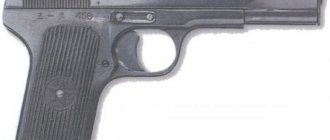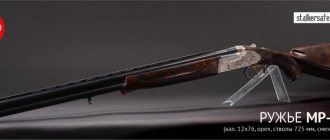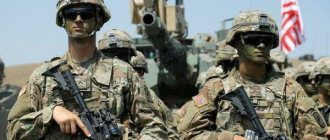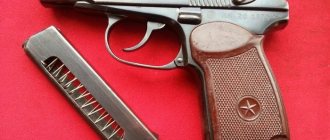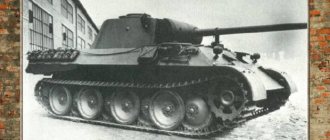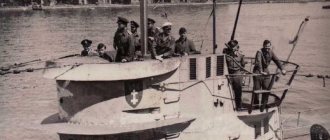A group of developers from the Naval Engineering University in Wuhan (PRC) managed to create a compact electromagnetic weapon of unprecedented power. The South China Morning Post reported this. The device is designed on the principle of a Gauss gun, has the form factor of a pistol with a barrel 12 cm long. Three electromagnetic coils are placed around the barrel, and the field generated by them is capable of ejecting a projectile with an initial energy of about 150 J. It is especially noted that such indicators were achieved through the use of artificial intelligence. No other details about the characteristics and capabilities of the Chinese “Gauss pistol” are reported. “Profile” decided to find out whether the imminent appearance of small electromagnetic weapons is possible.
- If we compare an electromagnetic gun with a regular one
- What are Gauss rifles capable of?
- What does artificial intelligence have to do with it?
“We need our own communism!”
The background to the development of Chinese weapons is known to everyone: the USSR armed its eastern neighbor “within the framework of international cooperation.”
Mosin carbines, DP-27 and Maxim machine guns, submachine guns went to China - everything that was left in warehouses from the Great Patriotic War and after mass demobilization was not really needed in the homeland. At the same time, technologies were transferred. The culmination of this process was the transfer of documentation for the production of the Simonov self-loading carbine and the Kalashnikov assault rifle, which were only recently adopted into service in the USSR.
But at the end of the 50s, after Comrade Mao declared that he would build his own communism (with the dazibao and the Red Guard maidens), the friendship ended. The entire corps of Soviet specialists folded and left the Middle Kingdom, and somehow it immediately became clear that the PRC would not receive fresh Soviet weapons know-how.
History of creation
The birth of the new Chinese pistol began in 1992 and ended in 1996. The weapon was created specifically for the PLA (People's Liberation Army of China) as part of a project to modernize the weapons arsenal. However, one of the hidden reasons was China’s desire to stand out from the crowd and use not foreign pistols in local conflicts, but its own analogues, which would be somehow different from the rest.
As a result, the creation of a new “cartridge-weapon” complex began, due to the high degree of saturation of armies around the world with individual means of self-defense. Without thinking twice, Chinese designers and engineers decided to settle on two selected calibers: 9 mm Parabellum (with improved characteristics and an increased powder charge, equal in power to world standards +P+) and 5.8 mm (a unified cartridge made in China). The nine-millimeter cartridge was called DAP-92, and the 5.8 cartridge was called DAP-5.8.
The QSZ-92 pistol, more precisely, the version for export to the USA - CF-98-9, which does not differ in anything from the QSZ, except for the inscription
The Chinese gunsmiths took the 5.7x28 caliber as a model, which, by the way, is used in the P-90 submachine guns. However, they did not want to simply take a ready-made cartridge, but upgraded it to a new caliber - 5.8x21 mm. The cartridge is pointed at the end, which has a positive effect on its penetration abilities, unlike the Parabellum, and its cartridge case is bottle-shaped. The management set strict conditions for the development of this caliber - the bullet must pierce a Chinese helmet at a distance of 50 meters. However, the Chinese worked so hard that it turned out even better: guaranteed penetration from a distance of 100 meters. Cartridge weight – 3 grams, initial speed – 480 m/s, muzzle energy – 344 J.
Regarding the 9-mm cartridge, gunsmiths from the Middle Kingdom also tried their best: they increased the charge of the cartridge, which made it possible to improve the combat qualities of the bullet. But due to the blunt shape of the nose, this caliber was less effective compared to 5.8 mm. Therefore, the Chinese began to produce a Parabellum pistol for export to the USA for sale, and their own 5.8 caliber for their own armed forces and police.
Get out yourself!
The Celestial Empire at that time was a rather unpleasant place, with which not a single developed state on the planet was in a hurry to embrace. No one was in a hurry to supply the aggressive communists with technology, but at the same time, the Communist Party and Comrade Mao personally demanded that weapons designers create weapons more effective than those of the potential enemy. How to use Soviet technologies to create a machine gun better than ? We decided to crossbreed what was available.
Early attempts to develop such hybrids include the Type 63, which was a mixture of the already mentioned AK (Type 56) and SKS (Type 56 carbine) with additions: the appearance, the folding needle bayonet and the automatic operation scheme were quite “Simonovo”, but here The barrel was locked with a rotating bolt, like on an AK. Only the gas engine was made of its own design. The store used was a detachable, sector-type one.
Type 68 assault rifle with stamped receiver - late version of Type 63
Since then, the Chinese have become very fond of the design with a short stroke of the gas piston - despite the somewhat lower (theoretically) reliability of such a design, it is more technologically advanced, and the weight of the bolt is significantly reduced, and this somewhat reduces the shaking of the weapon when firing. In the 60–80s of the twentieth century, hardworking designers created several more samples that, to one degree or another, combined AK and SKS in 7.62x39 mm caliber. But at the same time, they also looked towards Europe.
Fashion trends
In the second half of the 70s, Austria and France acquired new weapons developed in the bullpup configuration: these were, respectively, the Steyr AUG (StG-77) and FAMAS. Even small Finland released a limited edition Valmet M82, developed on the basis of the Kalashnikov assault rifle (more precisely, its licensed version).
The Chinese were prevented from making their own "Steyr" by the lag in technology - well, at that time the country did not have developed the production of high-strength plastics. But the production of AKMoids has not been a problem for a long time. The PRC got carried away by the fashion trend and produced its own version of the weapon called Type 86S. In fact, it was the most ordinary Kalashnikov, but with the bolt cocking handle located at the top, covered with an integrated handle for carrying the weapon (copied from the French FAMAS). The front and rear sights were hidden in the upper part of this handle.
Semi-automatic version Type 86S
From the Austrian AUG, the new machine gun received a folding front handle - in general, it turned out to be another hybrid. I’ll say right away: like the Finnish “Valmet M82”, the Type 86S turned out to be an unsuccessful model, it “didn’t work” for the army, and in foreign markets the commercial versions, converted for a single fire mode, sold poorly. It is now clear that “bulling” an AK is a thankless task; such a design has much more disadvantages than advantages (poor balance, excessive gas pollution right in front of the shooter’s face, inability to fire from the left shoulder, etc.).
But in the 20th century, many countries tried to step on the rake in their own way, including domestic designers of the Groza rifle-grenade launcher complex. The Chinese quickly realized that the bullpup needed to be built from scratch. And generally move away from the Soviet legacy.
What does artificial intelligence have to do with it?
Experts look at the Chinese new product, as well as at the prospects of Gauss guns as small arms, with undisguised skepticism.
“The statement about artificial intelligence casts doubt,” said military expert Konstantin Bogdanov . “In these devices, it all comes down to energy consumption: what impulse is given, the projectile flies.”
One of the problems of Gauss systems is low efficiency, for example, for the GR-1 rifle it is only 2.8%. Therefore, a possible direction for improvement is the creation of superconducting coils (which brings with it new difficulties) or replaceable capacitor banks.
Mikhail Degtyarev, editor-in-chief of the Kalashnikov magazine, shared his doubts . “I don’t understand what needs to happen for a compact system with the characteristics of a military weapon to appear in the coming years.”
The most likely trend in the development of electromagnetic weapons was considered to be the creation of ship guns based on railguns - in America they are called railgun, “rail gun”. In 2005, the US Navy announced a program to create Velocitas Eradico “rail guns”. It was assumed that such a weapon would be able to fire a projectile at a speed of 8.5 km/s to a range of up to 400 km. Destroyers of the Zamvolt class were to be armed with them. There were tests that caused a lot of noise, then the program stalled, and in 2021 its funding was stopped. One of the main reasons is the lack of sufficiently compact power supplies. And this was on a ship where a whole compartment was allocated for the power plant and capacitor batteries for the railgun!
Finally, this is an illustration: we managed to find a video where a British amateur designer demonstrates a “portable” rail gun capable of breaking through the skin of a car. The system weighs 113 kg and has the dimensions of a heavy machine gun, and the battery of capacitors for it almost completely occupies the trunk of a passenger car.
New times, new weapons, new cartridge
In the 70s, the leading powers acquired a low-impulse cartridge (and corresponding assault rifles), so the military leadership of the PRC realized the need to switch to new ammunition. And so that at least no worse than the neighbors!
Only a rich country that passionately cares about its own army can afford its own cartridge, different from world standards. And by the end of the 80s, a lot of money had finally accumulated in the Celestial Empire. After carefully studying the experience of others, in 1987 China adopted the 5.8x42 mm cartridge called DBP-87.
Cartridges 5.8x42 mm, 5.45x39 mm and 5.56x45 mm
The Chinese themselves claim that their product is significantly superior to both the American 5.56x45 mm and the domestic 5.45x39 mm. However, comparative tests have not really been carried out anywhere (in any case, open sources are silent about this). Experts cautiously suggest that the performance characteristics of the ammunition may indeed be 10-15 percent superior to foreign analogues. At the time of adoption, in any case, the DBP-87 confidently outperformed the domestic 7N10, not to mention the old 7.62x39 mm cartridges.
True, the improvement in performance also has a downside: when shooting at ballistic soap, it turned out that the DBP-87 bullet forms a temporary cavity of a smaller size than other low-pulse cartridges.
Exit holes from Chinese 5.8×42 mm DBP-87, American 5.56×45 mm M885, Russian 5.45×39 mm 7N22 bullets
By the way, at the time of the release of the new ammunition, weapons for it did not yet exist, so for army testing they created a small batch of modifications from the Type 81 assault rifle that was in service (and very successful), produced in 7.62x39 mm caliber.
Type 81
The tests showed good results, the military command approved the new product. Over time, the DBP-87 has undergone a number of upgrades; machine guns, magazine-fed and belt-fed machine guns, and even sniper rifles have been made into it. True, the Chinese failed to switch to a single-cartridge system, in which all army weapons use the same ammunition (this greatly simplifies logistics).
Miracles do not happen: a relatively small-volume cartridge case cannot accommodate a powder charge sufficient to throw a bullet over long distances. Therefore, in parallel with the main 5.8x42 mm, the old Russian cartridge 7.62x54R (and a bunch of others) remained in service in the Chinese army.
If we compare an electromagnetic gun with a regular one
Of course, the 150 J declared by the Chinese is not enough for serious firearms. Let’s compare: a Makarov pistol (PM) bullet has an initial energy of about 300 J, a Browning M1900 of 7.65x17 mm caliber has a muzzle energy of about 250 J. And only the almost toy “ladies’ Browning M1906” with a barrel a little more than 5 cm chambered for 6.35x15 .5 HR had a muzzle energy of around 100 J. The closest in characteristics to the product of Chinese gunsmiths is the so-called small-caliber rifle chambered for .22 LR.
Now about the principle of operation. The Gauss gun (named after the German scientist Carl Gauss) is a type of electromagnetic mass accelerator, known since the 19th century. Today, even schoolchildren can assemble it from scrap materials - I personally first saw such a device in the school labor room in the mid-1980s. The Guass gun barrel is made of a dielectric, around which one or more solenoids (inductors) are placed. A ferromagnetic projectile or simply an iron bullet is loaded into the breech of the barrel. When current is passed through the coils, a magnetic field is formed, which draws the projectile into the solenoid and accelerates it. And most importantly: to fire a shot, a short-term and powerful electrical impulse is required. To obtain it, large capacitors are used.
Prototypes of “Gaussians” were tested back in the 30s of the last century, but it was never possible to build anything suitable for military purposes. Today, the Gauss accelerator as a weapon is considered practically futile, and to create combat systems, military designers use the principle of a railgun (another type of electromagnetic mass accelerator).
...And don’t come back without your bullpup!
One thousand nine hundred and ninety-one. The United States is chasing the Iraqis into the Persian Gulf, the USSR is collapsing with a roar, hostilities begin in Yugoslavia, and China is adopting the QBZ-95 5.8x42 mm assault rifle. Despite the failure with the Type 86S, the new product was again made in the fashionable “bullpup” layout - and this time the body was still made of plastic. The dream of owning a “steyr” has come true.
The Chinese have not forgotten about the solutions borrowed from FAMAS. In general, the weapon turned out to be quite convenient, reliable and technologically advanced - automatic gas release, locking the barrel with a rotating bolt, short stroke of the gas piston.
This is not to say that the machine was completely devoid of shortcomings. In no case - all the disadvantages of classic bullpups remained with him, and cartridges were ejected only to the right, which is quite inconvenient for left-handers. Statistics say that 15 percent of the world is left-handed, therefore, in the two million Chinese army, 290 thousand soldiers experience some difficulties when handling standard weapons (in reality, of course, less).
Due to the developed upper handle, the sighting devices are placed very high - and with the attached magazine, the weapon has a large vertical dimension, and with the addition of a collimator or optical sight, their height above the barrel seems to become a record. Shooting from behind cover with such a kit is not very convenient, especially at close ranges...
In addition, the fire mode switch/safety switch was located in a completely inconvenient place - near the butt plate (but it blocked the trigger mechanism and was super reliable). In the latest version, however, this bug was eliminated and the part was moved to the fire control handle - now only the trigger is blocked. The Chinese soldiers compensate for the inconvenience of changing magazines with the hard work and perseverance characteristic of this people - and have achieved outstanding success in this field. You can, of course, blame them for their finger lying on the trigger during reloading, but this is not practical shooting, right?
The machine gun slowly acquired relatives: a light machine gun and a semi-automatic sniper rifle were created on its basis.
Type 95 light machine gun…
...and the QBU-88/Type-88 sniper rifle
Today, the QBZ-95 is the most common assault rifle in the armed forces of the People's Republic of China and, therefore, throughout the world (although it is practically never found outside the borders of the Celestial Empire). However, a commercial self-loading version, made in 5.56x45 mm caliber, is offered for export.
“Nothing can be more despicable than Chinese military power...”
In the 19th century, China more than once became relatively easy prey for European-style armies. Why did the richest and most populous empire with the most ancient traditions of statehood find itself in such an unenviable position?
A century and a half without wars
The Manchu tribes subjugated China during the years when the father of the future emperor-reformer Peter I reigned in Russia. It was then that the military system of the Manchu Qing dynasty was formed, which existed almost unchanged until the beginning of the twentieth century. The army of the Beijing Emperor consisted of eight Manchu, eight Mongol and eight Chinese “divisions”, organized into eight “banner” corps, each with its own colored banner.
Ethnic Manchus made up a little more than 3% of the population of the Qing Empire, but the backbone of the land army was made up of them and the related tribes of the Solons and Tibos. The second level in the imperial hierarchy was occupied by the Mongols, followed by the Chinese collaborators “Hanjun”, who served the Manchus even before the final conquest of China, and only then by the rest of the Chinese. In addition to the “eight banners” guard, local garrison and security troops were created from the Chinese, who were not part of the privileged “eight banners” system and were called “green banner troops”.
Manchu “general” from the “eight banner” guard, photo from the 19th century
In the 17th century, the military organization of the Manchus was not far behind the contemporary European level. However, soon the Qing Empire reached its “natural” borders - the “Middle State” and its weaker “barbarian tribes” vassals were surrounded on all sides by the almost deserted and rugged expanses of the world’s oceans, northern taiga, southern tropics and the world’s highest mountains of the Himalayas.
For a century and a half, Manchu China did not encounter an enemy with a developed military organization and technology. The European powers were separated by distant seas and, until the era of the steam fleet, simply did not have the opportunity to transfer sufficient forces to the borders of the Celestial Empire. Until the 20th century, the Russian Empire never had modern and numerous troops on its far eastern borders.
Manchu archers from the "eight banner" troops, photograph from the 19th century
Unrest of peasants in individual provinces, insignificant by Chinese standards, and a few local wars with an obviously weaker and less developed enemy on the distant borders - that was the entire combat experience of the Qing Empire from the end of the 17th century until the first clash with Europeans on November 3, 1839.
At the same time, China, with a population of 400 million, has had the largest peacetime army on the planet throughout these last century and a half. When the Napoleonic Wars raged in Europe, the peace of the Celestial Empire was guarded by a million soldiers - that is, even more than all the troops of Bonaparte at the beginning of 1812, at the moment of the highest military tension of the French Empire, which controlled almost all of Western and Central Europe.
Millions of Bogdykhan
The lists of the “eight banner” guard included 275 thousand fighters, the entire hereditary military class of the Qing Empire. A third of them were stationed as elite garrisons in the largest cities throughout China. About 650 thousand more, from 20 to 50 thousand in each province, made up the “Green Banner Troops,” which were recruited from the Chinese through free hiring and served in local garrisons. These troops performed all administrative functions, from purely military to police and even courier.
Of the eight Manchu “banner” corps, the corps of the “Yellow Banner with a Red Border” was considered the eldest, since the emperor and the imperial family were listed on its lists. The same corps included a company (“niru” in Manchu or “Zoling” in Chinese) of “Albazins”, descendants of Russian Cossacks taken prisoner by the Manchus during the long siege of Albazin (the Manchus called it Yaksa) in 1685.
“Yellow with a red border” - the banner of the senior corps-“banner” of the “eight-banner” troops
The capital's "eight-banner" troops had an elaborate and colorful structure in a medieval way. This, for example, included: the palace guard - "Jin-jun-ying" and the guard of the summer residence - "Yuan-ming-yuan", the guard at the imperial tomb - "Shao-ling-tzu-bin" and the special tiger company - "Hu -Qian-ying”, which included the best archers for imperial hunting. Among the capital's garrison there was also a special detachment of “tigers” - shield bearers, dressed in yellow striped suits, matching the color of tiger skin. In theory, they were intended to repel attacks of enemy cavalry by instilling fear in the horses with their costumes - alas, not all horses knew about the existence of tigers.
"Tiger" warrior from the imperial guard, drawing from the 19th century
The structure of the provincial “Green Banner Troops” was more functional. In addition to city garrisons, they included two separate corps that performed strategic tasks: the Ho-Piao Corps, which was responsible for protecting and maintaining numerous dams on the Yellow River, and the Cao-Piao Corps, which performed similar functions on the Imperial Canal, the main transport artery. central China, which supplied food to Beijing and the northern provinces.
The “Green Banner” soldiers were formed into infantry “ins” (battalions) of 500 people and cavalry “ins” (squadrons) of 250 people. Zhen-piao, or brigades, were made up of several “yings,” and all provincial troops were subordinate to the provincial commander-in-chief, “ti-du.” A clear system of organization and effective control by the central government were practically absent. The “Green Banner Troops” were a conglomerate of disparate regiments, detachments and garrisons. The level of training and conditions of service varied greatly, depending on the degree of corruption of officials in different provinces.
It must be added here that the Chinese appear to be a monolithic people only to an outside observer. In reality, it is a conglomerate of related ethnic groups that often do not understand each other - for example, the provincial dialects of northern Beijing and southern Guangdong are more different than Russian and Polish. So in that era, for many Chinese, permanent enmity with the Manchu authorities or neighboring clans was more pressing than any skirmishes with distant “barbarians.” In the 19th century, all those who fought with the Qing Empire essentially never encountered a united China...
The personnel of the “Eight Banner” Guard received a fairly high salary: ordinary metropolitan units received 4 lyans of silver per month, artillerymen – 3 lyans, privates – 1.5 lyans. In addition, each "eight banner" soldier and non-commissioned officer received 22 bags of rice per year. The officers of the Eight Banner Troops received, depending on their rank, from 45 to 80 liang of silver per month and a corresponding considerable number of bags of rice. Chinese soldiers of the green banner were much cheaper - from 1 to 1.5 liang per month and only 3.5 bags of rice per year.
Manchu from the "eight banner" troops, 19th century drawing
A silver liang at that time was approximately equal to 2 Russian rubles in silver. Thus, the salaries of soldiers and officers of the Qing Empire (especially the “eight banners”) noticeably exceeded the official income of officers of the Russian Empire (not to mention soldiers). But in conditions of embezzlement and corruption, the Chinese soldiers of the “Green Banner Troops,” according to numerous testimonies of contemporaries, led a completely miserable existence.
China's military budget in 1812 amounted to 51 million silver rubles (25,200,275 liang of silver) plus such an undetermined amount as 5,608,676 bags of rice. Even without these bags, this amount corresponds to the direct military expenditures of the Russian Empire in the year when the French burned Moscow.
Thus, China's numbers were fine. What was worse was that his huge army remained absolutely medieval. The level of military technology and tactics corresponded at best to the European Thirty Years' War (1618–48).
“But a neighbor is approaching them from the west...”
One of the first Russian sinologists, Zakhar Leontievsky, observed the annual review and shooting of the “eight banner” guards in the vicinity of Beijing in 1824. The description shows a “caracol” typical of European tactics of the 16th–17th centuries: successive volleys of alternating rows in a deep formation of riflemen. The guns described are a typical 16th century matchlock arquebus, used in Europe even before the advent of heavy muskets. The barrel is short, “about an arshin,” that is, more than 40 cm shorter than a Russian infantry rifle from the era of the Napoleonic War. The caliber is also smaller than the European one of those years (15 and 18 mm, respectively).
It is characteristic that the Chinese shooters did not use a ramrod - the bullet was simply lowered into the barrel. Such “arquebuses” and the tactics of their use made it possible to develop a fairly high rate of fire with a short range and no accuracy. The relatively small caliber and correspondingly low weight of the bullet and charge did not allow for effective penetration of armor, which explains the preservation of medieval armor in service with the Manchu army until the second half of the 19th century.
"Arquebusiers" of the Qing Empire, Chinese drawing from the 19th century
In addition to the Manchu “arquebusiers,” Zakhar Leontievsky describes detachments of foot and horse archers. Along with short infantry rifles, the warriors of the Qing Empire also used very long ones, up to 2 meters and with a caliber of 20–25 mm, usually firing several bullets at once. Faced with such a weapon during the First Opium War, the British, remembering the European Middle Ages, called it “gingals.”
When firing, such a heavy gun was served by two soldiers. One put the barrel on his shoulder and secured it tightly with a tourniquet, the other fired. According to eyewitnesses, due to the primitiveness of the matchlock device and the large amount of low-quality gunpowder used to fire such a “gingal”, the faces of many shooters bore traces of powder burns.
The situation with artillery was no better. Russian diplomat Yegor Kovalevsky, who visited Beijing in 1849–51, left an interesting description of the annual exercises of the capital’s artillerymen from the “eight banner” troops:
“There were up to two hundred guns, but what kind of guns! The cannons brought to the field are tied with ropes; some simply to beams laid flat, others to carriages, if you can call these ugly one-wheeled carriages the wheels of which dig halfway into the loose ground so that the rollback is not very strong.” According to Kovalevsky’s descriptions, the Chinese shot “without a diopter, by eye, knocking out wedges in front or behind, pulling with a rope to the right or loosening to the left.”
As we see, this is not even the era of the Thirty Years' War. Something similar happened in the battle of Pavia or at Ivan the Terrible during the capture of Kazan four centuries before the events described.
The stagnation in military affairs was also facilitated by the dominant neo-Confucian ideology in China, which sincerely considered the Celestial Empire to be the only center of the world and rejected any borrowing from near or distant “barbarians.” The new 19th century of “steel, steam and electricity” China, represented by the Qing Empire, formally met at the zenith of power - in addition to modern territory, including Tibet, Xinjiang and Taiwan, its borders covered Mongolia, Korea, Vietnam, Burma, Nepal, now Russian Tuva and Russian Primorye. But on the eve of the clash with the Europeans, the armed forces of China remained essentially the same army with which the Manchu tribal union conquered the Ming Empire two centuries ago.
It is not surprising that a contemporary of the Napoleonic wars, a Russian subject, an American of Irish descent, Peter Dobel (Peter Dubel), who visited China on trade and diplomatic affairs in 1818, left the first and very revealing description of the Qing army in Russia at that time:
“Nothing can be more contemptible than the structure of the Chinese military force... The Chinese infantry have weapons: long pikes, guns with wicks, short sabers... Their cavalry also has sabers; but their best weapon is a bow and arrows... There are more than a million warriors in Bogdykhan’s army. This may be true, but I can positively assure everyone that nowhere and never has there existed an army, with such a large number, so weak and incapable of defending the state and so completely ignorant of the art of war. I am sure that any European power, if only it decided to wage war with the Chinese, could very easily conquer this country; and I hope to live to see this era..."
The arrogant but observant European Dubel turned out to be a good analyst and actually lived “until this era” when, probably not without satisfaction, he read the news about the First Opium War. In the meantime, a quarter of a century before the collision of the British and Chinese empires, he prophesied: “The long-term peace that the Chinese enjoy has contributed greatly to the corruption of morals and the weakening of the spirit of vigor and courage. Perhaps there is no people in the world less warlike than the Chinese. And if China had not been surrounded by the sea and weaker neighbors, it would have long ago become the prey of the first brave conqueror. But now a neighbor is approaching them from the west, whom they should fear and against whom there is no defense. I mean the British in the East Indies, their possessions have already moved closer to the very borders of China...”
To be continued
Literature:
- Leontevsky Z. Great review of the Daiqing (Chinese) troops on November 3, 1824, magazine “Northern Bee”, 1832, No. 266, 267
- Iakinf (Bichurin). Chinese military forces. Magazine "Son of the Fatherland", 1840, volume V, No. 2.
- Chinese army and its firearms. Magazine "Library for Reading", 1840, No. 38.
- Kovalevsky E. Travel to China. Parts 1–2. SPb.: Type. Queen and K, 1853.
- Mertvago D. Essay on maritime relations and wars of Europeans with China until 1860, St. Petersburg: 1884.
- Putyata D. China. Essays on the geography, economic state, administrative and military structure of the Middle Empire and the military significance of the strip bordering Russia. St. Petersburg: Military printing house, 1895.
- Fan Wen-Lan. New history of China. Volume I, 1840–1901 M.: Foreign Literature Publishing House, 1955.
- Butakov A., Tizenhausen A. Opium wars. An overview of the European wars against China in 1840–1842, 1856–1858, 1859 and 1860. M.: Publishing house AST, 2002.
- Dobel P. Travels and the latest observations in China, Manila and the Indo-Chinese archipelago. M.: Publishing house Vostochny Dom, 2002.
If not for one “but”...
Part of the Chinese generals, apparently, believed that the country did not need its own “steyr”, but its own “SIG”, bearing in mind that the rifles of this company are deservedly considered the best mass-produced weapons in the world both in terms of accuracy and quality. Rightly pointing out the inherent shortcomings of bullpups, the generals pushed for the development of an assault rifle of a classical design. Actually, the design did not have to be developed “from scratch”: the donor was the same Type 81 with a folding stock, on which the DBP-87 was tested.
Automatic Type 81
The weapon, however, underwent a deep modernization, acquired a fashionable plastic body kit and, surprising as it may seem, was put into service under the name QBZ-03.
Automatic QBZ-03
Now the Chinese army has two very different (externally) machine guns with a single cartridge and magazines. The QBZ-03 is armed with auxiliary units - sappers, military police, etc. Despite its very good characteristics, it is unlikely that it will displace the QBZ-95 from its home. Rather, it will forever remain a kind of “second echelon”.
General opinion of gun experts about the pistol
Many owners of exported Chinese CF-98-9 pistols note its excellent ergonomics and light weight, thanks to which it fits comfortably in the hand. Disassembling the pistol is very simple: remove the magazine, then the bolt stop, remove the bolt casing along with the barrel. For reliability, Chinese designers designed 8 lugs on the rear side of the barrel, which securely fix the barrel. Practice shows that this method is so reliable that it allows the use of cartridges with power and pressure comparable to the European standard +P++.
CF-98-9 – Chinese pistol for export
The quality of manufactured parts is excellent. For comparison, the thickness of the bolt casing in the window for spent cartridges is 3.8 mm, while the Russian famous Viking has 2.2 mm.
